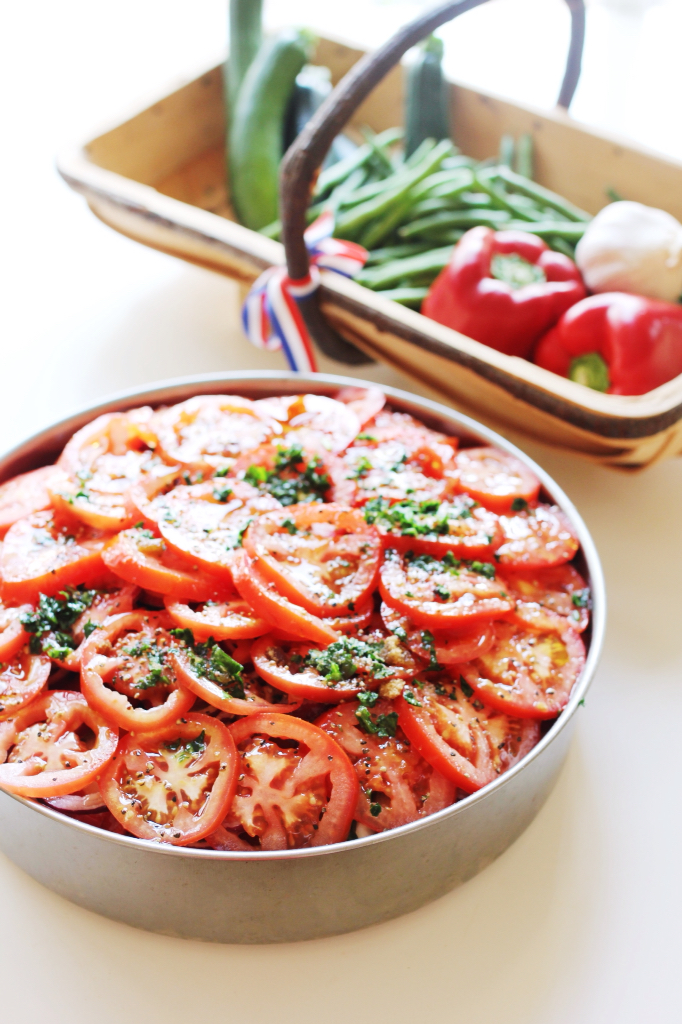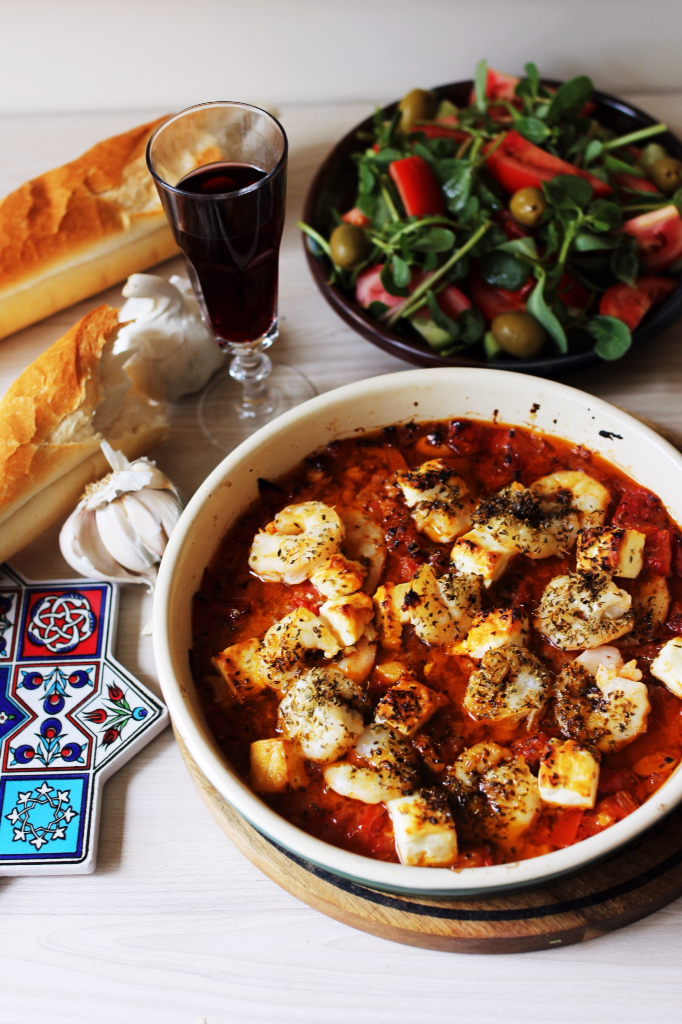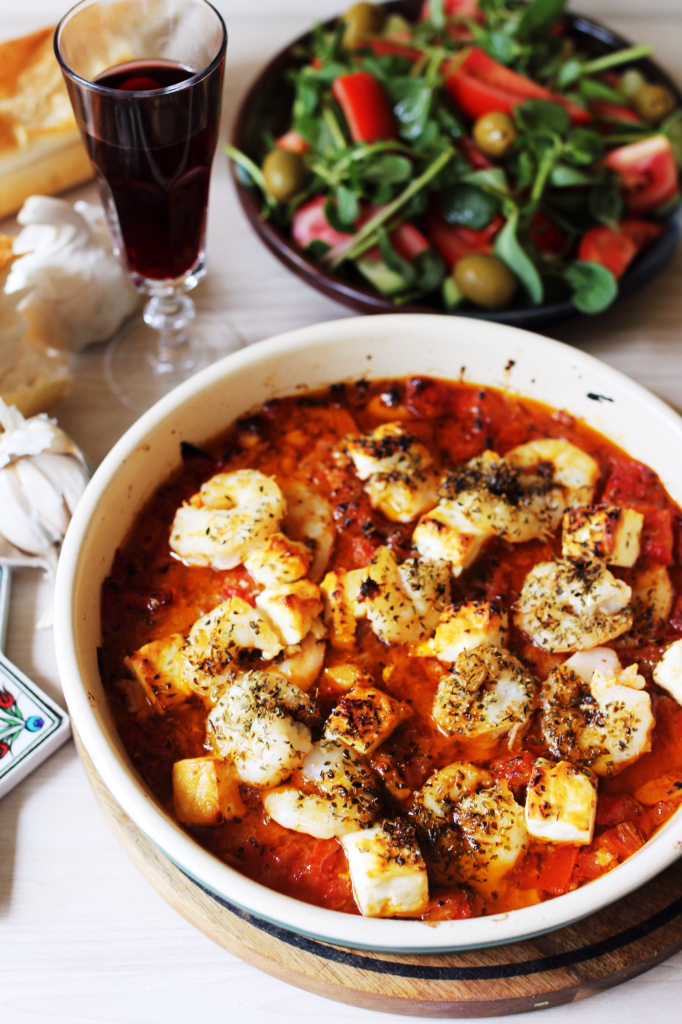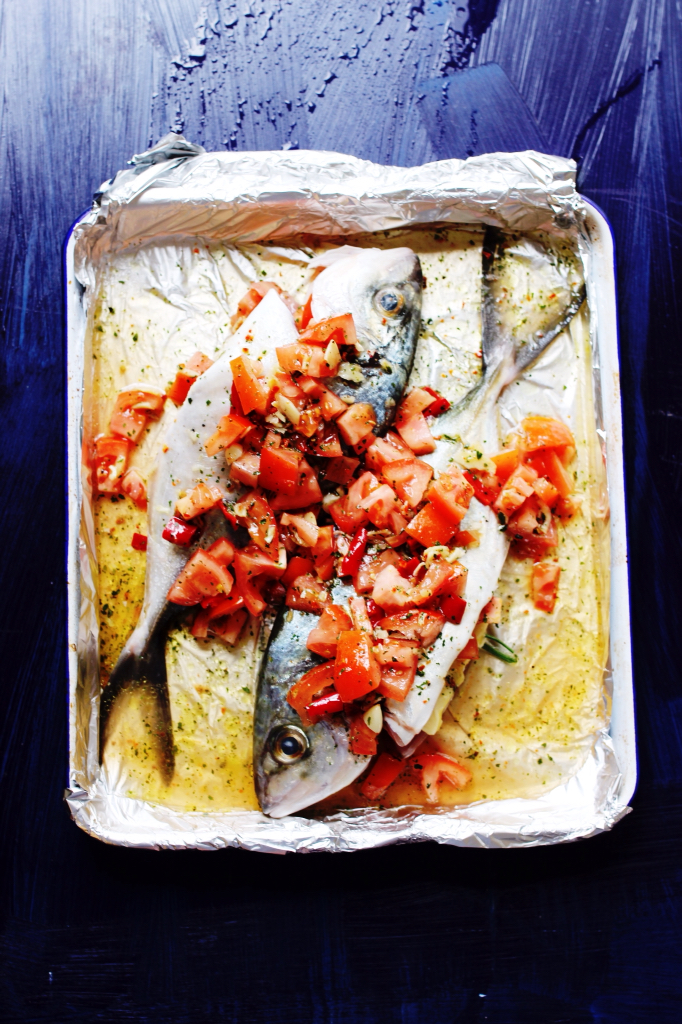Καλή Χρονια! Kali Xronia – happy new year!!
Καλή Χρονια and happy new year to our new host of 'In my Kitchen"Maureen and the same wishes - plus a big thank you to the creator of this series and host for many, many years, Celia. A happy new year also goes to you lovely readers and all of my fellow 'In my kitchen' bloggers.
The sentiments of Francesca, of Almost Italian are ringing true in my kitchen for the start of the new year. It's been a time for sea breezes and taking a break from anything too frantic in the kitchen department. This last week, post Christmas, has been about enjoying simple Greek flavours, fresh seafood and delicious summer vegetables.
In saying that however, the creation of our Christmas feast for 2015 - this year hosted by my mum and myself - was not exhausting in the least. My very clever Mr K had presented me with an early leave pass from work this year, in the form of a few beach filled couple of days in mid December. It was all heavenly 'beach, eat, sleep repeat' - and then I sailed (with plenty of beach inspired calm) into the pre-Christmas week to have a really enjoyable couple of days cooking and preparing for Christmas with my beautiful, zen like parents.
In fact, while I was totally spoiled with some thoughtful and generous gifts this year, the best gift was having some really happy and joyful times with my whole family - Mr K, my two sets of lovely parents, my aunt and uncle, cousins and my gorgeous Greek family. A big highlight was celebrating Ba's (my Greek dad's) 89th birthday on boxing day and seeing him preside over the cutting of the vasilopita on New Year's Day. My mum said it best in her Christmas card to my parents in law this year, when said that "our beautiful Greek-Australian family has enriched our lives so much".
And just in case you were wondering about who got the coin in the vasilopita (see my last post) - it was indeed Ba, to great applause and big 'ear to ear' smiles from the whole family. My sister in law, Joanne, also made a really delicious almond and coconut flavoured vasilopita (I'll be asking for that recipe soon) and Ba's namesake, my beautiful niece Sienna, also had the good fortune of finding the second coin for 2016. If the saying is true that you start the first day of the new year as you wish to see the year continue, then 2016 is going to be a truly wonderful year.
In my kitchen this January 2016...
...I have a couple of snapshots of Christmas day pinned on our fridge. A great way to reflect on such a happy day for many more days to come.
In my kitchen this January 2016...
...There is a plate of those cooling, extremely low effort summer mezedes I was talking about! Perfect for when you come home from a day at the beach - exhausted from doing nothing but swimming and sitting under the shade of a pine tree taking in the sea breeze. No matter how relaxed I am, I have been able to summon up the energy to place a few anchovies (which I had marinated in herbs and olive oil in the lead up to Christmas) on a plate and slice some wafer thin pieces of Avgotaraho.
![]()
In case you are wondering, Avgotaraho is the Greek name for these little wafer thin slices (which I think look a bit like panes of salmon coloured stained glass, flecked with saffron threads) and they are actually the salt cured roe of a mullet. It is a real delicacy in Greece and the whole of the mediterranean. Italians call this “Bottarga” and it features prominently in both Sicilian and Sardinian cooking. In Greece it has been eaten since Byzantine times and Mr K has been channeling all of his ancient Greek culinary heritage enjoying this local Australian version (although it was made by a Kastellorizian gentleman, as the fishmonger and one of his older Greek 'papou' clients informed us). All it needs is a judicious drop of good Greek extra virgin olive oil and squeeze of lemon. It also has to be enjoyed, of course, with a glass of Ploumari Ouzo (one of Mr K's Christmas gifts, which he was much delighted with) and splash of very, very chilled water and ice.
While I love the opaque colour and the smell of ouzo, despite all my Hellenic leanings, I can never seem to get through a glass off the stuff - no matter how good quality the ouzo is or how small the glass, or how strong the encouragement. It strange, as I love aniseed and fennel in all its other forms. Maybe one day my taste buds will get there. But for now, I've been enjoying another chilled Greek treat and a little something to counter balance all that French champagne at Christmas, a natural mineral water from the beautiful Greek region of Zagori. A real treat indeed, given it is nearly impossible to find here in Australia. The fantastic evil eye or 'mati' coasters were also a Christmas gift Mr K received and they have certainly bought a real Hellenic touch to cocktail hour at our house.
In my kitchen this January 2016...
... There has been some trevally. These beautiful fish have a firm, dense and slightly oily meat. As such, they benefit from having some robust flavours in the mix to compliment their oily flesh. Trevally (but not silver trevally) are also recommended as a better choice, when it comes to the issue of sustainability. We have enjoyed these lovely fish simply grilled on the BBQ, along with a twist on the traditional Greek lemon and olive oil dressing - a French dijon mustard, lemon and olive oil dressing! This mustard sauce is normally reserved for pork dishes, but it really works with the meaty flavour of the trevally.
![]()
We have also baked the fish in a Greek island way, with plenty of garlic, tomato, chilli and white wine - finished with some garlicky breadcrumbs. The finished dish is really something to savour over a long and relaxing lunch - and the perfect way to cook this sort of fish or any kind of mullet or even an Australian salmon (both sustainable choices). This method of preparing the fish is also really low effort - no pre-cooking of the tomato sauce is required, as there normally is for the more classic baked Greek fish dish - psari plaki. Just add all the sauce ingredients to a bowl, mix and then spoon over the fish. And vo-ila or should I say ...oriste!
Baked fish in the Greek Island Style
You need:
Two whole trevally or grey mullet (about 1kg)
1 cup of toasted fresh sourdough breadcrumbs
For the sauce:
100ml of extra virgin olive oil
1 glass of white wine
2 garlic cloves, finely chopped
1/2 cup fresh dill, finely chopped
1/4 cup parsley, finely chopped
1 red chilli, roughly chopped and de-seeded if you don't want the finished dish to hot
400g grams of ripe tomatoes, diced
salt and pepper
Method:
1. Mix all of the sauce ingredients (leaving aside a little dill to tuck into the belly of the fish later) in a bowl, season to taste and set aside.
2. Preheat the oven to 190C. Clean/trim the fish, rinsing well and pat dry. Place the fish on an oiled baking dish or tray and season with salt. Tuck a little bit of the reserved dill into the belly of the fish. Spoon the sauce over the fish and then place in the oven, uncovered, to bake for about 15 minutes.
3. Remove the fish from the heat, turn over and then spoon over the sauce from the tray. Top with the toasted breadcrumbs and bake uncovered for a further 20-25 minutes. Serve with lemon wedges and some boiled potatoes or home made chips for a simple summer meal.
Finally, in my kitchen this January 2016...
There has been plenty of items flowing from the fridge to the picnic basket, for beach side soirees done the Greek way. After indulging in perhaps a little to much meat over Christmas - from roasted duck with fresh cherries to lamb on the spit, I have been craving my much loved wild greens. So along for the ride to the beach there has been plenty of horta - boiled wild greens dressed in extra virgin olive oil and lemon, in the form of the first the season vlita (
find our more about this green here) and some slow cooked yellow split peas, called fava in Greek, dressed up with some zingy capers and chopped red onion.
Upping the vegetable quota has also been some rice and herb filled zucchini blossoms - a real summer treat, baked in fresh tomato sauce. The tomatoes have come from the early crop of ripe summer tomatoes growing in our garden. For good measure, I also added some small baby zucchini and a few 'comforting' potatoes to the zucchini blossoms. Last but not least for our recent beach picnic there was also some octopus, boiled at home to release all of its purple juices and then taken down to our local beach, to be grilled over charcoal. If you could bottle the smell of summer it would have to be salty sea breezes, charcoal and grilling octopus!
So that is my kitchen for this January! Thank you for taking the time out to see what is in my kitchen this month and please make sure to visit our host
Maureen at the Orgasmic Chef and see not only what is in her kitchen this January, but lots of other kitchens around the world!!



























































































